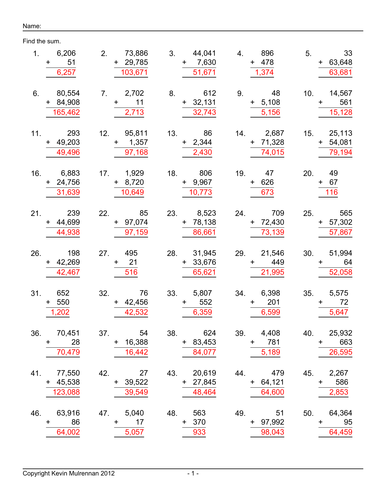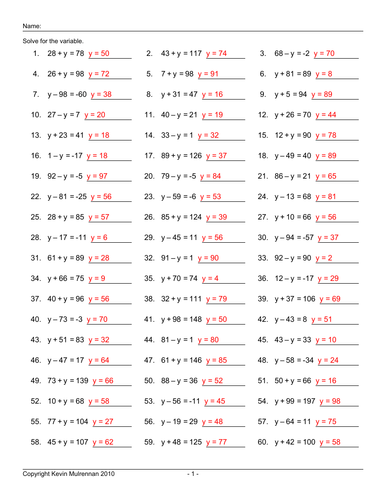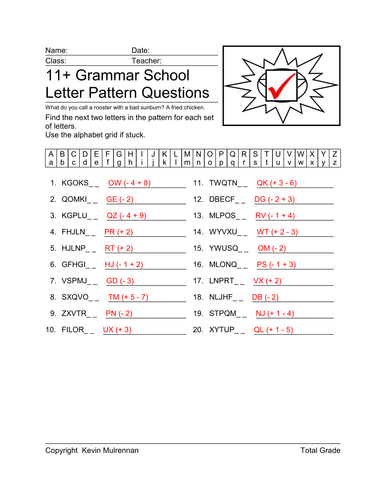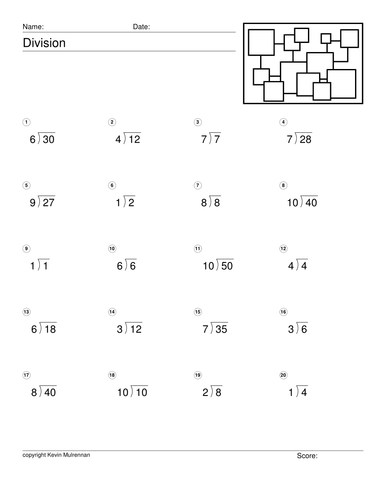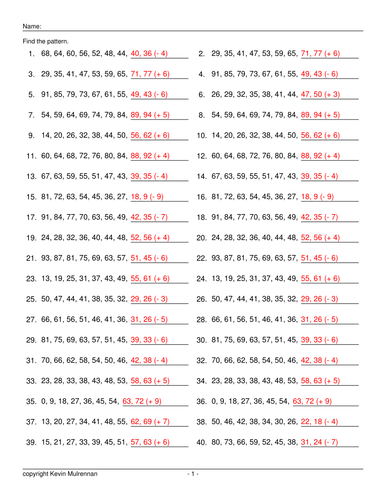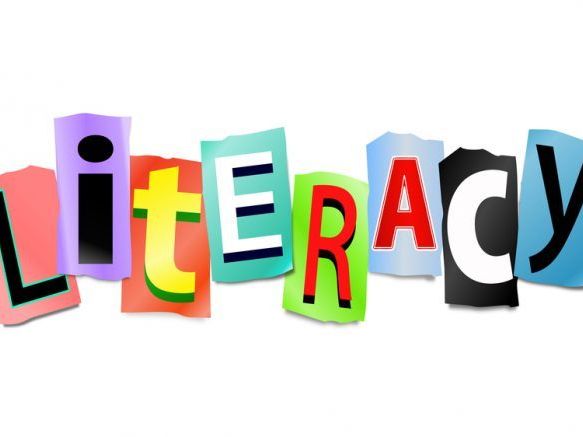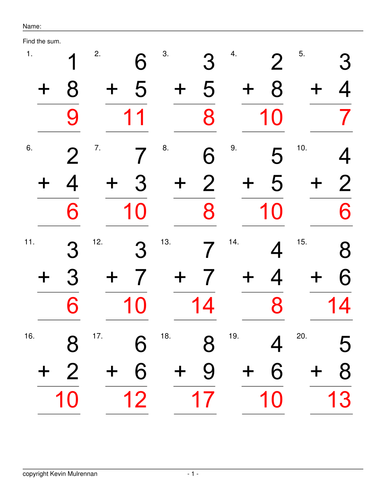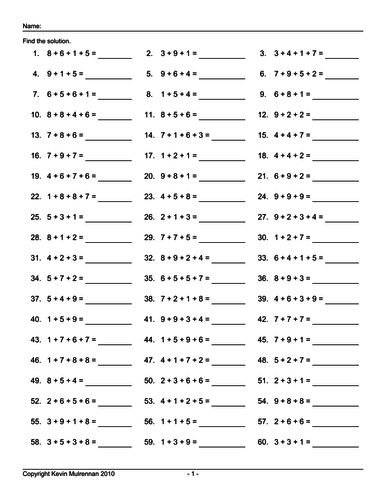340Uploads
99k+Views
29k+Downloads
Mathematics

1000 questions Maths Advanced Addition Mathematics
1000 questions Maths Advanced Addition
Answer sheets provided.
Good for homework
Good to fill time
Good extension work

Back to School Year 5 Autumn Term Mathematics 4 Groups
Some nice planning.
In 4 groups so lots of differentation.
Example :
L.O
To order positive and negative numbers and find differences between numbers
(not set) Dividing by 10,100 and 1000 quick fire questions Must: I can order sets of negative numbers Share with the children an image of a thermometer, what is it used for? What do we know about temperature? Children to mark on the thermometer temperatures they know ie body temp, boiling point etc.
Can temperature go below zero? What do we call those numbers?
Share with the children -15, -2, -20, -9 and -21. Where on the thermometer do these go? Discuss smallest to biggest ordering, which number is smaller/larger.
In pairs order a set of numbers (+ and -) L/A
Children to order sets of negative numbers. Moving on to reading temperature problems.
(activity 1-2 on pg6 NPM 6a)
Number lines/thermometer to support?

1000 Questions Advanced Addition Maths Mathematics KS2
1000 questions on advanced addition.
Pupils write the answers directly on the sheets. There are different numbers of digits that they can add up.
Answers all provided.

Year 4 Area and Perimeter Maths Lesson Plan Squares and Rectangles
Nice lesson.
Possible cross curricular links. Outside area planning.
Learning Objectives. Ma 1 Organising and explaining
Ma 3 Calculate perimeter/area of squares and rectangles.
• To explain methods and reasoning
• To solve mathematical problems, recognise and explain patterns and relationships.
• Calculate perimeters and areas of rectangles.
• Find the largest area that can be made with a rectangle that has a perimeter of 26 metres.
Success criteria.
• To be able to work out the area of a rectangle or square.
• To make different rectangles that all have the same perimeter.
• To recognise the largest area.
• To compare the relationship between the length of the sides and the area of the rectangle.
• To explain reasoning.
Mental/Oral. 10 mins. LSA to support LA children.
The answer is 16. What is the question?
Using the yes/no cards hold up the correct side in response to the question.
15 + 1, 10 + 4, 18 – 2, double 2 ……. (12 questions.)
Can we think of any more to add to the list?
Discuss any misconceptions as they arise, also the quick ways to add numbers mentally. Emphasis on bonds and doubles or near doubles.
With a partner, using InWB find as many questions as possible for the statement.
The answer is 24. What could the question be?
Vocabulary.
add
subtract
multiply
divide
double
near double
half
equals
Resources :-
Yes/No cards.
InWBs and pens.
Nice worksheets and powerpoint to do an investigation on the area and perimeter of squares and rectangles.
Possible cross curricular links. Outside area planning.
Learning Objectives. Ma 1 Organising and explaining
Ma 3 Calculate perimeter/area of squares and rectangles.
• To explain methods and reasoning
• To solve mathematical problems, recognise and explain patterns and relationships.
• Calculate perimeters and areas of rectangles.
• Find the largest area that can be made with a rectangle that has a perimeter of 26 metres.
Success criteria.
• To be able to work out the area of a rectangle or square.
• To make different rectangles that all have the same perimeter.
• To recognise the largest area.
• To compare the relationship between the length of the sides and the area of the rectangle.
• To explain reasoning.
Mental/Oral. 10 mins. LSA to support LA children.
The answer is 16. What is the question?
Using the yes/no cards hold up the correct side in response to the question.
15 + 1, 10 + 4, 18 – 2, double 2 ……. (12 questions.)
Can we think of any more to add to the list?
Discuss any misconceptions as they arise, also the quick ways to add numbers mentally. Emphasis on bonds and doubles or near doubles.
With a partner, using InWB find as many questions as possible for the statement.
The answer is 24. What could the question be?
Vocabulary.
add
subtract
multiply
divide
double
near double
half
equals
Resources :-
Yes/No cards.
InWBs and pens.

Year 4 Numeracy Planning lots of lessons Powerpoints pdfs Notebook files
Some great planning you can use throughout the year for year 4 Maths.
I’ve divided it into 9 blocks.
sample planning :
Partition, round and order four-digit whole numbers; use positive and negative numbers in context and position them on a number line; state inequalities using the symbols
MA2 L3 How many _ in each number? Children recognise how many Th, H, T & U are there WALT – Order and partition 3 and 4 digit numbers
WILF – knowledge of place value
Well organised work
Pupils to be reminded of place value. Which column to we go to first to see which the bigger number is? What does it mean to partition a number? Children work though a couple of t. led examples.
MA – 4 digit number sheet (MT)
A – 3 digit number sheet (Indep)
LA – partitioning 2 digit numbers. Discuss what each number is made up of - which is the biggest number in a group. Q? What happens if we swap the t & u around? (JH) Prep for Tue – do any children remember the rule for rounding. Discuss in talk partners and report back
Partition, round and order four-digit whole numbers; use positive and negative numbers in context and position them on a number line; state inequalities using the symbols How many _ in each number? Children recognise how many Th, H, T & U are there WALT – round numbers to the nearest 10, 100 and 1000
WILF – rounding numbers accurately
Mental addition of 2 digit nos
Well organised pencil procedures Remind pupils of the findings from yesterday’s plenary. How do we round to the nearest 10? What about to the nearest hundred. Children put rule to the test using whiteboards to assess understanding. Children will be asked to add two numbers mentally and round the answer. Which mental strategies could we use? Ch discuss best way. MA to use pencil a paper proc with bigger numbers.
Differentiated worksheets MA – ind A – MT less able JH Investigation. What is the highest and lowest numbers that will round to 4000. What is the difference?
Multiply and divide numbers to 1000 by 10 and then 100 (whole-number answers), understanding the effect Children to use whiteboards – 10 x =
Division Q? For MA WALT – multiply divide whole numbers by 10, 100
WILF - Understanding of the process
Well organised work
Moving onto decimals
Mental maths methods
What happens to a number when you multiply it by 10? Key points Children will know that add a 0 is not the correct answer. Decimal point stays in the same place.
All children start by demonstrating their knowledge of mult by 10 and 100 then dividing by 10 100
MA – working with a mixture of whole and decimal numbers (JH)
A – using whole numbers only
LA – multiplying by 10 JH Who can explain the rule? Pupils are given 3 minutes to come up with the rule for multiplying by 10 or 100. Feedback to the rest of the class

Year 5 Maths Investigations Nice Short Pithy Exercises
A series of short but interesting Maths investigations.
Nice worksheets for year 5 pupils.
Bits on tally charts and graphs.
Nice powerpoint on reading scales.

Euro Coins European Worksheets 500 Questions Mathematics Counting KS1 KS2
500 questions on counting up Euro coins.
5 worksheets with 100 questions each.
There are little pictures of the coins and the pupils have to add them up and write the answers on the sheet.

Year 5 Maths Fraction word Problems 2 Differentiated sheets Multiplication Methods
Week’s planning.
sample :
L.O. To apply understanding of multiplication facts.
Knowledge Harvest: What do chn know about multiplication and place value? I.e. when multiplying using the formal method, numbers need to be set out accurately, what methods do the children know? i.e. partitioning and formal written method.
Have 5x2x6 on the board. What is the answer? How do I work this out?
Once chn have got the answer, discuss whether it matters if the numbers are in any order.
Resources:
Dice: 1 between 2
Vocab:
Multiplication, number facts, digit, numbers, single digit,
LO: To revise calculation of multiples of 10.
Have some numbers on the board. Can chn partition them? Discuss that in 4567, the “4” has a value of “4000”. Link this to the Place Value grid (ThHTU). Remind chn that the units column is now called the “ones” column.
Have a 356 x 10 on the board. How can we work this out? Discuss different methods that the chn may come up with.
Do chn (LA) realise that you can move the digits, or will they try to use the formal method?
Clear up any misconceptions that we just add a zero or move the decimal point.
Adult to remind chn of the clue. Look at the amount of zeroes to see how many places the numbers need to be moved.

1000 questions Equations Single Variable Mathematics KS2 Algebra
1000 questions with answers on Equations.
Single variables.
Pupils have to work out what y equals.

11+ Verbal Reasoning Questions Letter Patterns Vol 2
Another 100 worksheets on volume 2. I've included more questions per sheet and for some I have omitted the alphabet grid. I have designed 100 worksheets on letter patterns for the 11+ non verbal reasoning questions. There are 100 worksheets provided on a cd. Letter patterns is an important aspect of the 11+ exams. Ideal for parents, pupils and tutors. Answer sheets provided. Introduce some logic and problem solving skills to students with the Letter Patterns worksheet. Sets of letters related in some way are displayed. Students must find the next two letters in the pattern for each set of letters. You can see an answer sheet in my picture with the answers in red.

11+ Verbal Reasoning Questions Letter Patterns Vol 1
I have designed 100 worksheets on letter patterns for the 11+ non verbal reasoning questions. There are 100 worksheets. Letter patterns is an important aspect of the 11+ exams. Ideal for parents, pupils and tutors. Answer sheets provided. Introduce some logic and problem solving skills to students with the Letter Patterns worksheet. Sets of letters related in some way are displayed. Students must find the next two letters in the pattern for each set of letters. You can see an answer sheet in my picture with the answers in red.

100 Questions on Pythagoras Answers Provided Mathematics Geometry KS2
**100 questions on Pythagorus.
IF YOU LIKE THUS I HAVE A REALLY BIG FILE IN THE SHOP
15000 Pythagoras Questions Pythagorean Theorem Maths KS2 KS3
Answer sheets provided.
A good little exercise for your students. Using a calculator this should keep them busy and help you teach Pythagoras’ theorem.**

Division Worksheets for Primary School Children Maths Mathematics Homework
100 worksheets with answers sheets provided.
100 sheets of division questions.
Some have 10 questions, some 20, some 50.
A useful time filler or use them for a quick homework or start of day activity.

Maths Patterns 100,000 Questions Numeracy
I have designed 100,000 questions on Maths patterns. You have to guess the patterns and fill in the answers. Makes a pleasant change from the same old same old textbooks that are around. You can use your professional judgement to choose the appropriate sheet. You can pick and mix, leave questions out etc. it’s your choice! Answer sheets are provided for all worksheets.

Year 5 Literacy and Maths Planning
Gathered together my lessons for year 5 Maths and English for a particular year. There’s about a year’s worth in there.
Plenty of great ideas. the zip has the lot. the general download a few to have a look at.
Sample planning :
Start by showing the word ‘Instructions’ – TTYP what does this mean?
Come back together and establish that instructions are a set of commands given to help someone do or create something.
Show the children a recipe and the instructions as to how to play Sevens using cards. Look at the instructions. What do children notice about how these are laid out? They are given in an order.
They are bullet-pointed.
Each sentence is fairly short.
There are many ‘bossy’ verbs: ‘place’, ‘play’, ‘turn’ etc. Explain that we call these ‘imperative’ verbs – an imperative is a command. Discuss why it is helpful to have ‘bossy’ verbs and short clear sentences.
There is a title which tells you what is to be achieved.
Numbers or time connectives used e.g. 1, 2, 3 or later, next - are used to show chronological order.
Create a features list on the working wall by sticking post it notes onto a piece of sugar paper –these can be used throughout the unit as a game to start the lesson.
Divide the class into three teams. Deal out seven cards to each team and the teacher! Play a little of the game of sevens, following the instructions. Demonstrate how we can follow the instructions to play.
Return to features of instructions displayed on working wall.
What can you remember about these? Children turn to a partner and tell them 3 different features. Report back & discuss.
Show children the instructions checklist (working wall). Have we mentioned all of these features?
Ask children to think of a new idea for a card game. Use a talking partner & brainstorm a game idea on whiteboards.
Gather everyone’s ideas/discuss the concepts. Pick one idea.
Decide how many players we will need & how to play it. Allow children time with talking partners to practice playing the game. Ask some children to demonstrate.
How will we write the instructions? What comes first? (Title, subheading.) What is our first instruction? Repeat for a few more sentences.

Year 3 Literacy and Maths Planning
Gathered my lessons for year 3 together.
Mainly Literacy and Maths plus bits and bobs.
In the zip you find the lot. Included some examples in general upload.
Sample planning :
Introduction
Explain will be looking at different ways of writing poetry using special words and shapes as stimulus. ‘calligram’ means beautiful writing.
Show examples.
S&L
Children discuss with response partner why they think words are presented in these ways. Teacher draw children back together.
After discussion, ask children to choose most effective calligram, justifying choice.
Draw out understanding that the meaning of words inspires the shapes in a calligram.
Teacher demonstrate use of ICT programs to produce calligrams and own drawing as alternative.
Draw up a list of suitable words for choices.
Word/Sentence Activities
Use IWB store range of suitable words for calligrams. Can children classify word types: nouns, adjectives, adverbs etc.
YEAR 3 LITERACY LESSON PLAN 16th Monday
Whole Class Shared Learning
Before reading; ask the children what they think ‘Autumn’ poem will look like.
Show poem. Ask them to decide where you should begin reading and then read the poem.
Read two more examples of shape poems.
Add appropriate actions. Class repeat.
S&L
Encourage the children to say how similar and different the three poems are. Invite them to say which poem is most effective visually. Which poem do they prefer? Discuss why the poets have chosen these shapes, and how the shape affects the content of the poems.
Practice with RP saying preferred poem aloud.
Word/Sentence Activities
Rehearse spellings for Word Wall words. Challenge children to find other words with same phonemes

15000 Pythagorus Questions Pythagorean Theorem Maths KS2 KS3
Loads of questions on Pythagoras plus answers.
Excellent for practice or homework.
The zip file contains a pdf of 3750 pages of questions. The answers file is the same.

Year 2 Planning Literacy and Maths
Gathered my lessons for year 2 together.
Mainly Literacy and Maths plus bits and bobs.
In the zip you find the lot. Included some examples in general upload.
Sample planning :
Read the traditional tale LRRH, recap ‘good’ central character/villain. Concentrate on the attitude, not words. What would happen if we reversed the characteristics?
S&L
Children discuss how a ‘good’ wolf might behave towards LRRH/Granny.
Teacher draw children back together. Model how to ‘tell’ story of wolf from new pictures.
Word/Sentence Activities
IWB available for quick phonic session.
YEAR 2 LITERACY LESSON PLAN WEDNESDAY
Whole Class Shared Learning
Return to the traditional tale of LRRH.
Remind children about their previous day’s pictures. What did they do? How did they change the Wolf? Is he still the villain?
S&L
Ask the children to look at their pictures as you read story extracts with his dialogue.
Encourage them to discuss dialogue with a partner. Do the pictures and words make sense together?
As a class, agree that the Wolf needs new words. Discuss what he might say. Model how to write words for a speech bubble.
Word/Sentence Activities
Rehearse spellings for Word Wall words. Challenge children to find other words with same phonemes

100 Worksheets Addition Maths Easy at Start Hard at the End
100 worksheets on addition.
I’ve used a nice big font.
They start off easy then get progressively harder.
Answer sheets provided for all worksheets.

1000 Questions Addition Mathematics KS1 Adding Up
1000 questions with answers.
Pupils have to add up either 3 or 4 numbers under 10.



